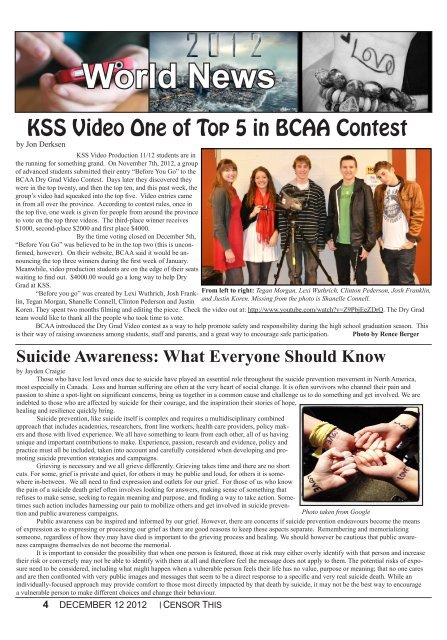CENSOR THIS! - Kelowna Secondary School
CENSOR THIS! - Kelowna Secondary School
CENSOR THIS! - Kelowna Secondary School
You also want an ePaper? Increase the reach of your titles
YUMPU automatically turns print PDFs into web optimized ePapers that Google loves.
KSS Video One of Top 5 in BCAA Contest<br />
by Jon Derksen<br />
World News<br />
KSS Video Production 11/12 students are in<br />
the running for something grand. On November 7th, 2012, a group<br />
of advanced students submitted their entry “Before You Go” to the<br />
BCAA Dry Grad Video Contest. Days later they discovered they<br />
were in the top twenty, and then the top ten, and this past week, the<br />
group’s video had squeaked into the top five. Video entries came<br />
in from all over the province. According to contest rules, once in<br />
the top five, one week is given for people from around the province<br />
to vote on the top three videos. The third-place winner receives<br />
$1000, second-place $2000 and first place $4000.<br />
By the time voting closed on December 5th,<br />
“Before You Go” was believed to be in the top two (this is unconfirmed,<br />
however). On their website, BCAA said it would be announcing<br />
the top three winners during the first week of January.<br />
Meanwhile, video production students are on the edge of their seats<br />
waiting to find out. $4000.00 would go a long way to help Dry<br />
Grad at KSS.<br />
“Before you go” was created by Lexi Wuthrich, Josh Franklin,<br />
Tegan Morgan, Shanelle Connell, Clinton Pederson and Justin<br />
Koren. They spent two months filming and editing the piece. Check the video out at: http://www.youtube.com/watch?v=Z9PbjEeZDrQ. The Dry Grad<br />
team would like to thank all the people who took time to vote.<br />
BCAA introduced the Dry Grad Video contest as a way to help promote safety and responsibility during the high school graduation season. This<br />
is their way of raising awareness among students, staff and parents, and a great way to encourage safe participation. Photo by Renee Berger<br />
Suicide Awareness: What Everyone Should Know<br />
by Jayden Craigie<br />
Those who have lost loved ones due to suicide have played an essential role throughout the suicide prevention movement in North America,<br />
most especially in Canada. Loss and human suffering are often at the very heart of social change. It is often survivors who channel their pain and<br />
passion to shine a spot-light on significant concerns, bring us together in a common cause and challenge us to do something and get involved. We are<br />
indebted to those who are affected by suicide for their courage, and the inspiration their stories of hope,<br />
healing and resilience quickly bring.<br />
Suicide prevention, like suicide itself is complex and requires a multidisciplinary combined<br />
approach that includes academics, researchers, front line workers, health care providers, policy makers<br />
and those with lived experience. We all have something to learn from each other, all of us having<br />
unique and important contributions to make. Experience, passion, research and evidence, policy and<br />
practice must all be included, taken into account and carefully considered when developing and promoting<br />
suicide prevention strategies and campaigns.<br />
Grieving is necessary and we all grieve differently. Grieving takes time and there are no short<br />
cuts. For some, grief is private and quiet, for others it may be public and loud, for others it is somewhere<br />
in-between. We all need to find expression and outlets for our grief. For those of us who know<br />
the pain of a suicide death grief often involves looking for answers, making sense of something that<br />
refuses to make sense, seeking to regain meaning and purpose, and finding a way to take action. Some-<br />
times such action includes harnessing our pain to mobilize others and get involved in suicide prevention<br />
and public awareness campaigns.<br />
Public awareness can be inspired and informed by our grief. However, there are concerns if suicide prevention endeavours become the means<br />
of expression as to expressing or processing our grief as there are good reasons to keep these aspects separate. Remembering and memorializing<br />
someone, regardless of how they may have died is important to the grieving process and healing. We should however be cautious that public awareness<br />
campaigns themselves do not become the memorial.<br />
It is important to consider the possibility that when one person is featured, those at risk may either overly identify with that person and increase<br />
their risk or conversely may not be able to identify with them at all and therefore feel the message does not apply to them. The potential risks of exposure<br />
need to be considered, including what might happen when a vulnerable person feels their life has no value, purpose or meaning; that no one cares<br />
and are then confronted with very public images and messages that seem to be a direct response to a specific and very real suicide death. While an<br />
individually-focused approach may provide comfort to those most directly impacted by that death by suicide, it may not be the best way to encourage<br />
a vulnerable person to make different choices and change their behaviour.<br />
4 DECEMBER 12 2012 <strong>CENSOR</strong> <strong>THIS</strong><br />
From left to right: Tegan Morgan, Lexi Wuthrich, Clinton Pederson, Josh Franklin,<br />
and Justin Koren. Missing from the photo is Shanelle Connell.<br />
Photo taken from Google







